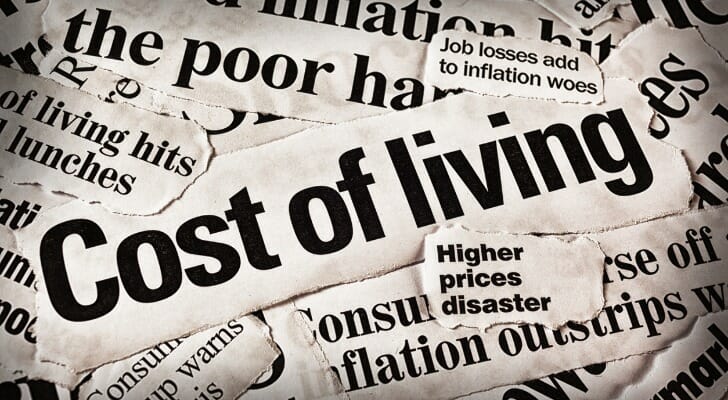The consumer price index (CPI) is one of the nation’s most closely watched economic metrics. The CPI, which comes out monthly, measures the year-over-year change in the cost of a basket of consumer goods, including clothing, food and furniture. The reason the CPI is closely watched is that it can augur both inflation and deflation. Here’s what you need to know about the CPI and why it matters to you. If you’re worried about preparing your finances for any potential movements in the economy, consider talking to a financial advisor.
Inflation and the Consumer Price Index
Our economy experiences inflation whenever prices consistently go up and the value of the dollar goes down. Your purchasing power drops, so the money you have in your wallet and bank account won’t buy you as much as it did before. The consumer price index (CPI) is one way that the federal government keeps track of the rate of inflation. It looks at how the average costs of certain items rise and fall over a specific period of time. While the information is available monthly, you can also search for a yearly CPI, as well as separate indices for 26 metropolitan regions.
You won’t find details in the CPI about shifts in prices for every single good or service known to man. Its market basket (the set list of items from certain sectors that is meant to be representative of the economy) measures how much households are spending on more than 200 different types of items: food, clothing, housing, transportation, education, recreational activities, medical treatment and fees for parking, water and other government services.
It even includes any taxes you’re charged when you shop or pay for a service. But the CPI doesn’t consider the price changes of things like bonds, real estate, life insurance or stocks – in other words, things that are investments rather than daily expenses. The CPI can be very specific. The index takes note of the spending habits of everyone who’s working and living in an urban area, including the poor and the unemployed.
So it covers about 87 percent of the country’s population, excluding people in rural areas and those in the military and in prison. You can find different versions of the index, too. The chained consumer price index adjusts for the chance that people will choose to buy lower quality, less expensive products when there is inflation. There’s also the consumer price index for urban wage earners and clerical workers (the CPI-W) that only factors in data for households that have most of their income coming from hourly wages.
Calculating the Consumer Price Index

To gather the information for the CPI, the Bureau sends out employees to collect the prices of about 80,000 products and services every month. It also surveys about 14,500 households each year to find out how much they’re spending on products for their families. All of the items in the CPI’s market basket are assigned a weight based on the percentage of spending that they make up.
After figuring out which items go into the fixed basket and determining the price of each item, finding the CPI involves multiplying the current price of one item by the number of those items in the basket and repeating the same step for all of the other items in the basket.
You can then add all of those products together to find the price of your market basket in one year. Finally, you complete the consumer price index formula by dividing the cost of a market basket in one year by the cost of the basket in a comparison year and multiplying the quotient by 100.
Why the Consumer Price Index Matters
So why should we care about the CPI? Besides helping us identify inflation, the CPI can tell us how the economy is doing and if there’s deflation — meaning that prices overall are dropping. Members of the government can look to the CPI when making policy decisions about the economy.
And because it’s often used as a measure of cost-of-living, the CPI helps to determine how much money you’ll get in benefits from programs like Social Security, food stamps and veterans’ assistance programs. In some ways though, the CPI is not that useful. The index doesn’t reflect changes in the quality of items over time and can’t tell us much about the spending patterns of the poor, or of people living outside of urban areas.
The CPI does not explain how income taxes or anything that happens in the environment might affect prices. Adding new items to the market basket isn’t an ideal solution because you need the basket to remain fixed in order to compare prices across multiple years. Plus, if you’re trying to figure out how much house you can afford, keep in mind that the CPI actually uses rental costs to show the monthly price of having your own home.
The CPI is often referred to as headline inflation because it doesn’t remove any items from its index that could skew its data. Core inflation, on the other hand, ignores food and energy because they often have sudden price shifts. Because of this, some see core inflation as a more accurate measurement of price fluctuations.
The Bottom Line

By revealing how prices go up and down from year to year, the consumer price index can help policymakers and economists identify inflation and decide on economic policy tweaks. It’s not a perfect tool, however, which is why there are other tools to measure inflation. For example, “core inflation” is a measure of inflation that excludes goods vulnerable to price shocks, including food and energy.
Why do we care about inflation at all? Because we want to maintain – if not improve – our standard of living, and we can’t do that with diminished purchasing power. Naturally, beating inflation is a key concern when it comes to investing. It’s a big part of why investors who aren’t afraid of a little risk choose stocks over bonds. Now that you understand the CPI and how it’s measured, you can consider your own personal strategy for beating inflation. Happy investing!
Tips for Managing Finances
- Working with a financial advisor can be one of the best ways to financially prepare for the ebbs and flows of the market and economy as a whole. Finding a financial advisor to work with doesn’t have to be hard. SmartAsset’s free tool matches you with up to three vetted financial advisors who serve your area, and you can interview your advisor matches at no cost to decide which one is right for you. If you’re ready to find an advisor who can help you achieve your financial goals, get started now.
- Wondering how the economy has been impacted by inflation or how it could be? Check out our free inflation calculator.
Photo credit: ©iStock.com/Monticelllo, ©iStock.com/RapidEye, ©iStock.com/Orientfootage
